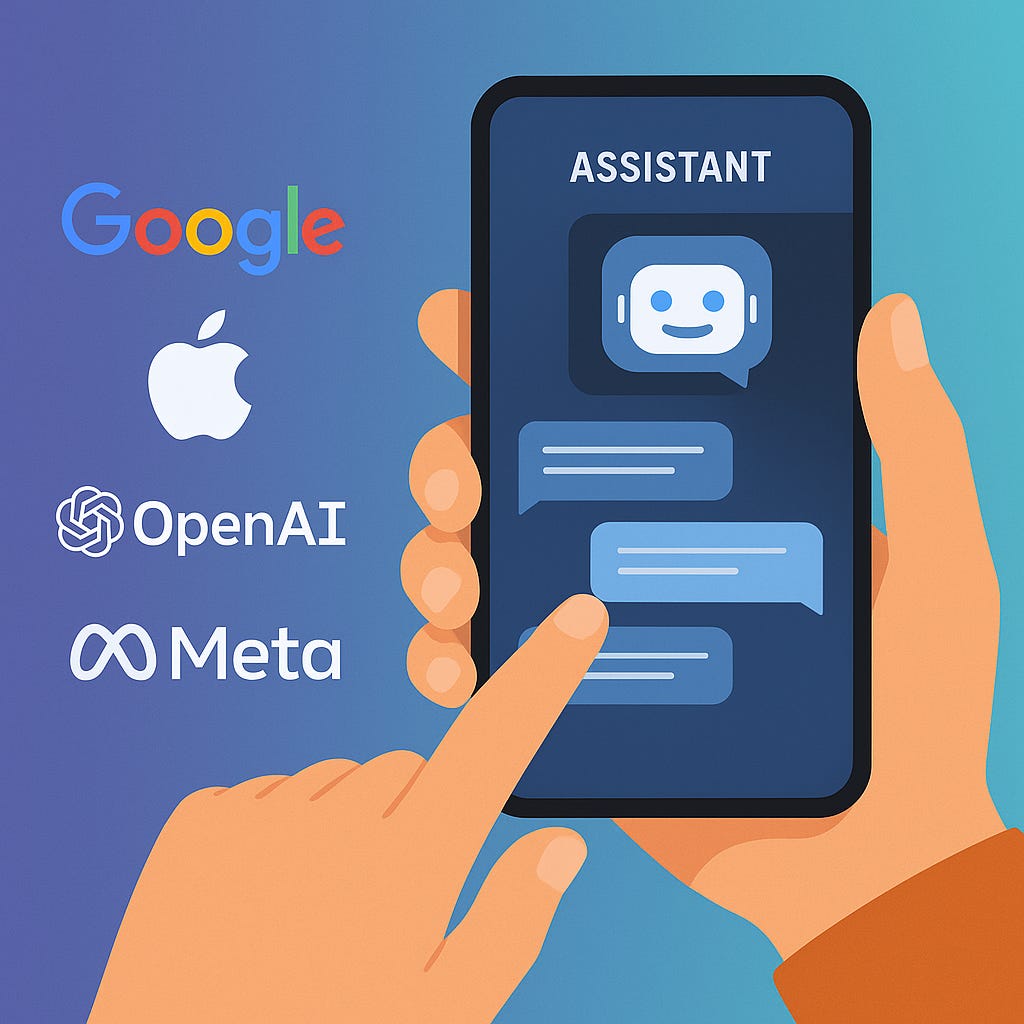- Yaro on AI and Tech Trends
- Posts
- 🧠Synthetic Brains Made from Human Neurons Are Now for Sale.
🧠Synthetic Brains Made from Human Neurons Are Now for Sale.
Plus: The Everything App is coming.
Sign Up -.- LinkedIn -.- Grow With Us -.- Our AI Business Services
Mid-Week Team, Straight out of a sci-fi story, you can now buy a synthetic brain, just in case LLMs are not enough. The race to build the ultimate “everything app” is on, and simplicity is the goal: one interface to do it all, powered by your data. To make it work, companies need more data centers, more power, and more compute, and every country wants in on the action and the investments that come with it. Let’s dive in.
🧰 AI Tools - To train models using images
Synthetic Brains Made from Human Neurons Are Now for Sale
Step-by-Step: From Human Cells to Biocomputer
🧠 Learning Corner - Computer Recognition.
The Everything App is coming.
Brazil Joins Global Race to Attract AI Billions.
📰 News and Trends.
📰 AI News and Trends
The easy access that scammers have to sophisticated AI tools means everything from emails to video calls can’t be trusted.
Google's Demis Hassabis says AI is already taking jobs and will create 'very valuable jobs,' and advises studying STEM subjects right now.
Google’s NotebookLM now lets you share your notebook and AI podcasts publicly.
Fortnite creators can now create AI-powered NPCs that work similar to the recently-launched AI Darth Vader.
🌐 Other Tech news
Neuralink competitor Paradromics completes first human implant.
Meta buys a nuclear power plant, kind of.
TikTok will give advertisers even more data on trends and users.
Apple to overhaul its chip design for the 2026 iPhones, plans, for the first time, to use advanced multi-chip packaging in a mobile device.
Chinese Robotaxi Companies Look to the Middle East for Growth.
StartEngine’s $30M Surge — Own a Piece Before June 26
Private markets are having a moment, thanks to companies like StartEngine.
The leading alternative investing platform is helping everyday investors like you access deals once reserved for VCs and insiders, including exposure to private market titans like OpenAI, Databricks, and Perplexity.¹
How’s it going? In Q1 2025, StartEngine pulled off $30M in revenue, its biggest quarter ever (based on unaudited financials).²
But StartEngine isn’t just a middleman. The company earns 20% carried interest on select pre-IPO offerings, unlocking value for shareholders when these deals succeed.³
How can you tap into this diversification play? By investing in StartEngine.
StartEngine has crowdfunded $85M+ to date, and you can join 45K+ shareholders before the company’s current round closes on June 26.
Reg A+ via StartEngine Crowdfunding, Inc. No BD/intermediary involved. Investment is speculative, illiquid & high risk. See OC and Risks on page.
The Everything App is coming.

Google, Apple, Meta, OpenAI, and others are racing to build AI-powered “everything apps” that merge search, assistants, and productivity tools into one seamless interface. Some already have devices in the market, while OpenAI is collaborating with Jony Ive to develop a new AI-first device designed for natural, always-on interaction.
Google’s new AI Mode, now live in the U.S., replaces traditional search with a conversational assistant that can answer questions, make reservations, analyze images, and more, leveraging personal data to deliver tailored results.
With AI rapidly advancing, we may soon rely on 24/7 assistants that know our habits, environment, and needs, marking the end of traditional “search” as we know it.
🧰 AI Tools
To train models using images, sounds, or poses, with minimal coding.
Lobe - Train custom image classification models locally using a drag-and-drop interface. Great for teaching AI to recognize images (e.g., plants, signs, gestures).
Roboflow - Build and deploy computer vision models (image detection, segmentation). Train on custom object datasets for tasks like face masks, vehicles, etc.
MediaPipe + Colab Notebooks - Real-time pose, hand, face, and object tracking using Google Colab to build custom models. Build gesture- or movement-recognition models similar to pose detection in Teachable Machine.
Edge Impulse - No-code/low-code platform to train ML models for embedded devices (images, sound, motion). Great for wearable tech, sound recognition, or real-time sports feedback.
MakeML - Build object detection and image segmentation models for iOS/macOS apps. Train models for AR or mobile apps with fast export to CoreML.
Download our list of 1000+ Tools for free.
Now You can Buy a Synthetic Brain donated by real Adults.
I a recent interview Yann LeCun, Chief AI Scientist at Meta, said that there is no “We are not going to get to Human Level AI by just getting bigger LLMs, there is absolutely no way.” “A country of genius in a data center is completely BS.” AI can coma up with all the data we have compiled in a very organized format ia matter of seconds, but it wont find creative or innovative solutions to current or future problems anytime soon. I believe this is completely true, a large data center will allow systems to store gigantic amounts of data with a very sophisticated retrieval system for us to access AI using interfaces like ChatGPT, it will allow for AI agents, robotics, advance autonomous vehicles, and higher inference.
But, I just found a company developing a technology out of a sci-fi book. Something that may allow these new technologies to actually merge with real brains to come up with the independent thinking these AI systems lack. Cortical Labs, a Australian startup has launched the CL1, the world’s first commercial biocomputer combining 800,000 live human neurons with silicon chips. Priced at $35,000 per unit, it allows researchers to run real-time experiments with brain cells capable of learning and adapting through sub-millisecond electrical feedback loops.
I was curious how this entire process works and this is what I found:
Cortical Labs' CL1 biocomputer combines live human neurons with electronic hardware to create a working system that can process information biologically. Here's a breakdown of how they built it:
Step-by-Step: From Human Cells to Biocomputer
Cell Sourcing
They start with skin or blood samples from adult donors.
These cells are reprogrammed into induced pluripotent stem cells (iPSCs), which can then become neurons.
Neuron Culturing
The iPSCs are differentiated into lab-grown human neurons.
Cultures are grown in the lab on multi-electrode arrays (MEAs)—silicon chips that can send and receive electrical signals to/from the neurons.
Integration with Hardware
The neurons are placed onto a silicon chip with embedded electrodes, forming a biological-electronic interface.
These chips are embedded in the CL1 unit, which includes:
A life-support system (temperature, nutrients, waste management)
High-speed signal processing electronics
Firmware for interfacing code with neuron behavior
Real-Time Electrical Communication
Neurons generate and respond to electrical pulses, just like in the human brain.
The system sends digital signals (bits) as pulses, reads the neurons’ responses, and loops this in real time (sub-millisecond).
Programming & Control
Developers use simple code layers to interact with the neurons.
The firmware interprets input/output and enables tasks like learning behavior, pattern recognition, or response to drugs.
Packaging & Distribution
The final CL1 is a plug-and-play system sold for in-lab use.
Each unit includes the wetware (neurons), chip, control board, and life support, ready for scientific or industrial applications.
Requirements
Buyers must have a certified cell culture lab and obtain ethical approval to work with live neurons.
Alternatively, users can rent access via Cortical Labs' cloud platform for remote experiments.
This process merges stem cell bioengineering, chip design, and neuromorphic computing to bring a real “brain-on-a-chip” system to market for the first time.
Key specs and features:
800,000 lab-grown neurons per unit, viable for up to 6 months
Consumes 850–1,000 watts, significantly less than traditional AI data centers
Cloud access available via “wetware-as-a-service” for $300/week/unit
59 input channels and onboard life support system
Potential applications include drug discovery, neurocomputation, AI acceleration, and Bitcoin mining. It's already shown promise restoring function in epileptic neural cultures and outperforming deep learning algorithms in some tasks.
Backed by $11M in funding, including from In-Q-Tel (CIA's VC arm), Cortical Labs sees the CL1 as a leap toward bioengineered intelligence—machines designed with the adaptability and efficiency of biology.
🚀 Bring Your Website to Life with an AI Chatbot
We just created a chatbot for this newsletter. I want to create one for you.
Save time and invest it where it matters most — your growth.
We’ll build a custom AI chatbot trained on your content (PDFs, site, FAQs) that answers customer questions 24/7, captures leads, and cuts your support load in half.
✔️ Built in 48 hours
✔️ No coding needed
✔️ Fully branded for your business
Let’s build your chatbot and turn your site into a smart assistant.
Brazil Joins Global Race to Attract AI Billions.

Jensen Huang in Brazil.
Brazil is rolling out tax breaks, import duty exemptions, and regulatory perks to attract AI-focused data centers, aiming to drive up to R$2 trillion (~$390B USD) in investment over 10 years. The package includes mandates for local computing use (10%) and contributions (2–8% of revenue) to a national development fund. Brazil’s clean energy is a key competitive edge in the carbon-conscious tech economy. However, critics cite a lack of transparency, limited job creation, and legal uncertainty as potential pitfalls.
There is definitely a growing global trend of nations offering incentives to anchor AI infrastructure within their borders, and it will continue to grow.
🧠 Learning Corner.
Teachable Machine - Train a computer to recognize your images, sounds, & poses.


Reply